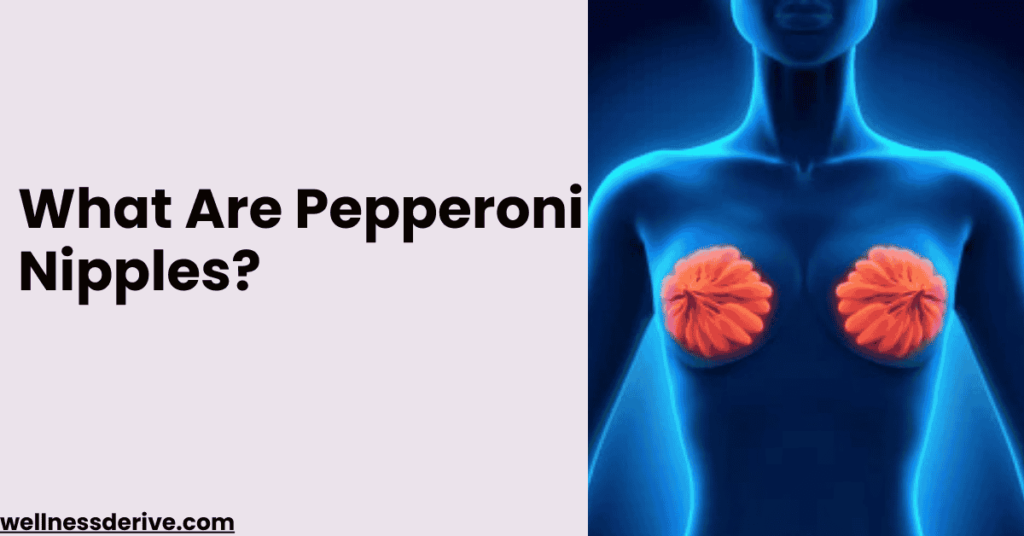The term “pepperoni nipples” is often used to describe a particular appearance of areolas that are larger and darker than average. While the phrase might sound casual or even humorous, it’s a completely normal trait that many people have, similar to other variations like elastic nipples. Understanding what pepperoni nipples are, why they occur, and whether they are a cause for concern can help normalize this unique characteristic.
What Are Pepperoni Nipples?
Pepperoni nipples refer to areolas—the pigmented area surrounding the nipple—that are larger in size and may have a darker coloration, resembling the size and appearance of a slice of pepperoni.
Key Characteristics of Pepperoni Nipples
- Large Areolas: The areola diameter is noticeably larger than what is typically considered average.
- Darker Pigmentation: The areola’s color may be deeper, ranging from dark pink to brown.
- Prominent Nipples: In some cases, the nipples themselves may be more pronounced or protruding.
It’s important to note that the size, shape, and color of nipples and areolas vary widely among individuals, making pepperoni nipples a normal and natural variation.
What Causes Pepperoni Nipples?
Several factors influence the size and appearance of areolas. Here are some common reasons why someone may have pepperoni nipples:
1. Genetics
Your genetics play a significant role in determining the size and color of your areolas. If larger areolas run in your family, it’s likely you’ll have them too.
2. Hormonal Changes
Hormonal fluctuations during puberty, pregnancy, or menstruation can cause the areolas to darken and enlarge temporarily or permanently.
3. Pregnancy and Breastfeeding
During pregnancy, the areolas often become larger and darker to help guide a newborn during breastfeeding. This change can persist even after breastfeeding ends.
4. Weight Changes
Significant weight gain or loss can alter the appearance of the breasts, including the size of the areolas. Increased fat tissue may make the areolas appear larger.
5. Puberty
During puberty, the breasts develop, and changes in the areolas, including increased size, are common as the body matures.
6. Natural Aging
As the body ages, hormonal changes and skin elasticity can affect the appearance of the areolas, potentially making them larger or changing their color.
Are Pepperoni Nipples Normal?
Yes, pepperoni nipples are entirely normal. The size and color of areolas vary significantly from person to person, and there is no “correct” or “ideal” size or shape.
Nipple and Areola Variations
- Some people have small, pale areolas.
- Others have large, dark areolas, often described as pepperoni nipples.
- Areolas can also be asymmetrical, with one being larger or darker than the other.
These variations are all part of normal human anatomy and are not typically a cause for concern.
Also Read: What is Ideal Breast Size : Based on Height and Weight
When Should You Be Concerned?
While pepperoni nipples are normal, changes in the size, shape, or color of the nipples or areolas could indicate a medical issue. Here are some signs to watch for:
1. Sudden Changes
If your areolas or nipples change significantly in size, color, or texture without an obvious cause (such as pregnancy), consult a healthcare provider.
2. Pain or Discomfort
Pain, swelling, or tenderness in the nipples may indicate an infection or other underlying condition.
3. Discharge
Unusual discharge from the nipples, particularly if it’s bloody or occurs without stimulation, should be evaluated by a doctor.
4. Skin Changes
Rashes, crusting, or dimpling around the areolas or nipples can be a sign of skin conditions or breast health issues.
If you experience any of these symptoms, it’s essential to seek medical advice for proper evaluation and treatment.
How to Embrace Pepperoni Nipples
Body positivity and self-acceptance are crucial when it comes to embracing your unique features. Here’s how you can feel more confident about pepperoni nipples:
1. Educate Yourself
Understand that nipple and areola variations are normal and part of natural human diversity.
2. Celebrate Individuality
Remember that no two bodies are the same, and your features make you unique and beautiful.
3. Avoid Comparisons
Media and societal beauty standards often present unrealistic images. Focus on how your body feels, not how it looks.
Frequently Asked Questions
1. Do Pepperoni Nipples Affect Breastfeeding?
No, the size or color of your areolas does not impact your ability to breastfeed. Babies latch onto the areola and nipple, so size variations are not a concern.
2. Can Areolas Become Smaller Over Time?
In some cases, weight loss, hormonal changes, or surgery can reduce areola size, but significant changes are rare without intervention.
3. Are Pepperoni Nipples More Common in Certain Groups?
Genetics play a significant role, so traits like larger or darker areolas may be more common in specific ethnic or familial groups.
Conclusion
Pepperoni nipples, characterized by larger and darker areolas, are a natural and normal variation of human anatomy. Influenced by genetics, hormones, and life changes, they are not a cause for concern. Embracing and celebrating body diversity helps promote confidence and self-love. If you ever experience unusual changes or discomfort, consult a healthcare provider for guidance. Your body is unique, and every feature contributes to its beauty.
Disclaimer: The content on Wellness Derive is for informational purposes only and not a substitute for professional medical advice, diagnosis, or treatment. Always consult a healthcare provider for medical concerns.



